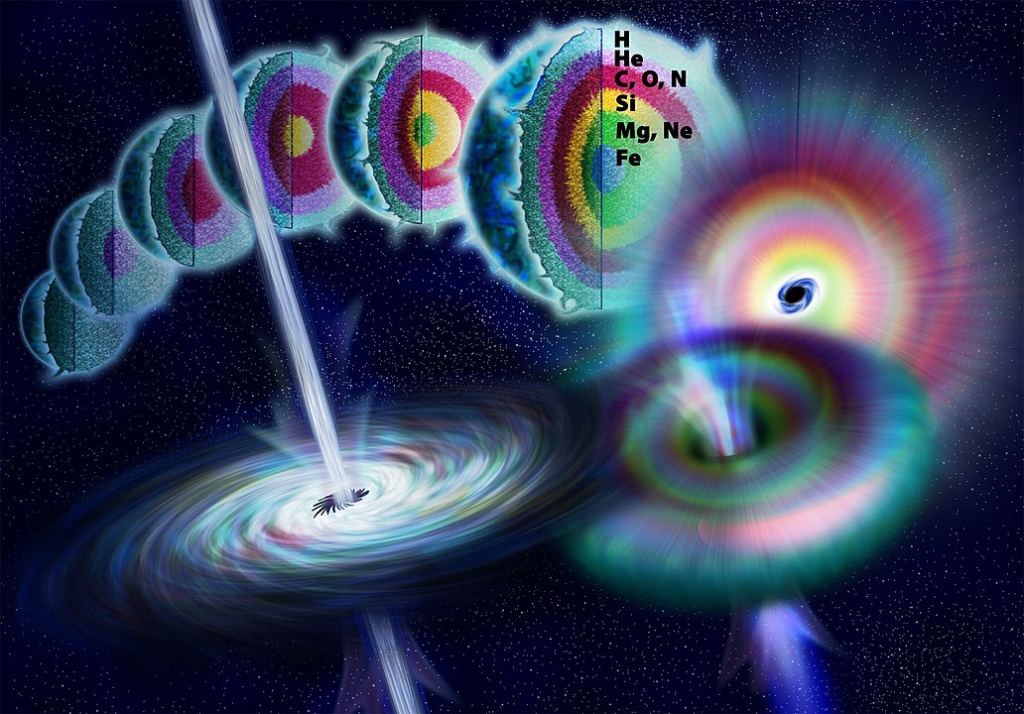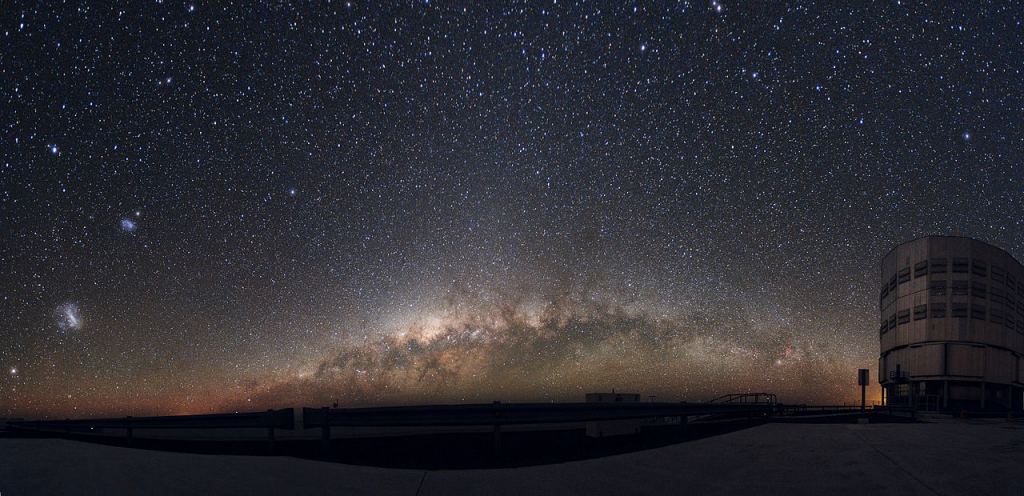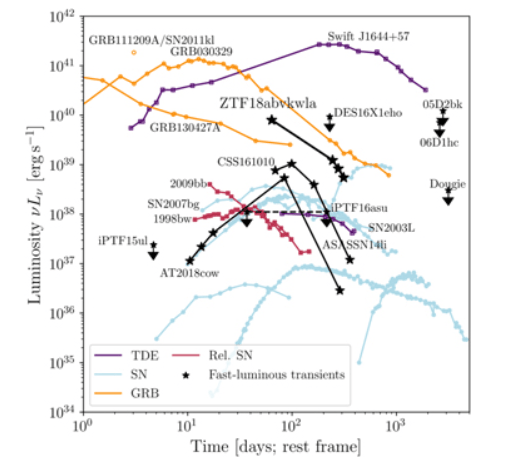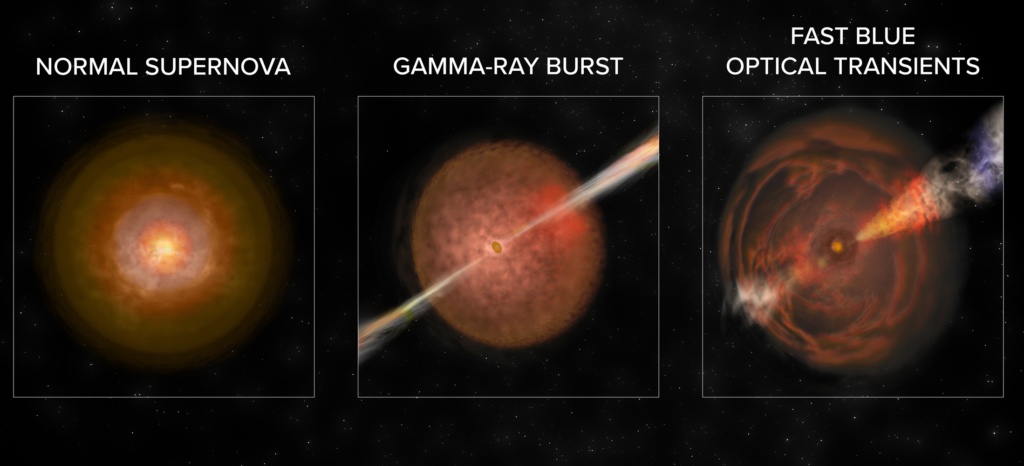For the child inside all of us space-enthusiasts, there might be nothing better than discovering a new type of explosion. (Except maybe bigger rockets.) And it looks like that’s what’s happened. Three objects discovered separately—one in 2016 and two in 2018—add up to a new type of supernova that astronomers are calling Fast Blue Optical Transients (FBOT).
Supernovae are kind of like fiery car crashes: we can’t help but look at them. They’re the fiery explosion at the end of a star’s life. Over the years, astronomers have observed them and their remnants, have come to understand them, and have classified them into groups.
But in 2018, astronomers were observing one supernova that didn’t fit into any group. It was called AT2018cow, or “The Cow.” The Cow garnered a lot of attention from astronomers around the world. Initially, it was unusually bright, and it brightened and then faded very rapidly.
Two other stellar explosions, one in 2016 and one in 2018, also caught the eye of the astronomy community for similar reasons. They were called CSS161010 and ZTF18abvkwla (“The Koala”). The Koala showed extremely bright radio emissions, as bright as a gamma-ray burst (GRB). And CSS161010 ejected an abnormal amount of material into space, at half the speed of light.
“When I reduced the data, I thought I had made a mistake.”
Anna Ho, Caltech
These results are published in two separate papers.
One is titled “A Mildly Relativistic Outflow from the Energetic, Fast-rising Blue Optical Transient CSS161010 in a Dwarf Galaxy.” The lead author is Deanne Coppejans, of Northwestern University. It’s published in the The Astrophysical Journal Letters.
The other is titled “The Koala: A Fast Blue Optical Transient with Luminous Radio Emission from a Starburst Dwarf Galaxy at z = 0.27.” The lead author is Anna Ho of Caltech. It’s published in The Astrophysical Journal.
The CSS and the Koala supernovae were both discovered by automated sky surveys in optical light. The CSS s/n is in a galaxy about 500 million light years away, and Koala is in a galaxy about 3.4 billion light years away. Both of those host galaxies are small dwarf galaxies.
SN2018cow was discovered in 2018, also by an automated sky survey. The Cow is about 200 million light years away, and is also in a dwarf galaxy.

When studying Koala, lead author Anna Ho noticed right away the surprisingly high levels of radio emissions. In a press release, she said “When I reduced the data, I thought I had made a mistake.”
CSS161010 was surprising too, though for a different reason initially. Co-author of that study, Raffaella Margutti, of Northwestern University, said in a press release, “It took almost two years to figure out what we were looking at just because it was so unusual.”
After more observations, it became apparent that both CSS and the Koala share similarities with The Cow. They called them Fast Blue Optical Transients, and they constitute a new type of stellar explosion that differs from other known types.
FBOTs start out much the same as other types of supernovae. When a large star—more massive than our Sun—reaches the end of its life of normal fusion, it can no longer sustain its core against its own gravity. The star explodes and expels its outer layers into space, leaving behind only a remnant. There are variations to how the different types of supernova undergo change, but that’s the top level view of a core-collapse supernova.
But FBOTs differ in what happens after the explosion.
Ordinarily, once a core-collapse supernova explodes, it sends a blast wave out into space in all directions, as an outward-travelling sphere. That can leave a black hole, or a neutron star, as the supernova remnant. In some cases, a rotating disk of material—an accretion disk—can form around the remnant for a brief time. That rotating disk can cause jets of matter out into space in opposite directions, and those jets can produce narrow beams of gamma rays: gamma ray bursts.

The entire phenomenon of the rotating disk, jets, and gamma rays is called an “engine.”
The difference with FBOTs is that the accretion disk is surrounded by a thick cloud of matter. The astronomers think that the matter came from the surface of the star before it exploded, possibly drawn off the star by a companion star.
When the blast wave from the supernova strikes that thick material, it causes the unusually bright blast of visible light at the start of the supernova that attracted astronomers’ attention in the first place. That initial bright burst led to the name Fast Blue Optical Transient.
In the paper led by Ho, the authors write that “Prior to core collapse, massive stars can undergo mass loss via steady winds or eruptive episodes (Smith 2014). As a result, a star can be surrounded by dense, recently expelled material at the time of explosion. If this material is optically thick, it increases the effective radius of the star and prolongs the light curve from shock breakout.”

Credit: Bill Saxton, NRAO/AUI/NSF
When the blast struck the material, it also caused a bright burst of radio waves. According to astronomers, that extraordinarily bright radio burst signalled that there was an engine at work.
The shroud of dense material “means that the progenitor star is different from those leading to gamma-ray bursts,” Ho said in a press release. The astronomers said that in the Cow and in CSS161010, the dense material included hydrogen, something never seen in in gamma-ray bursts.
Astronomers then turned to the Keck Observatory. Those observations showed that all three of these FBOTs are in smaller dwarf galaxies, rather than larger types. There’s no certainty yet of what that fact means.
There are still lots of questions, of course.
Even though all three of these FBOTs have central engines, it’s too soon to even conclude that they’re all supernovae. Black holes could create these same engines by shredding stars. But the astronomers are much more confident that supernovae are responsible, rather than black holes.

Though there could be different progenitors for these FBOTS, possibly black holes, there are some clues that they are indeed stars going supernova. One of them comes from Koala, and the galaxy it arose from. Very recently, that galaxy experienced a pronounced burst of star formation. According to the astronomers behind the Koala study, that makes the massive star progenitor more likely than the black hole progenitor.
“Remarkably, the Keck data showed the host galaxies of CSS161010, the ‘Koala,’ and the ‘Cow,’ while tiny, are actively forming stars, indicating their home base has a very small stellar mass typical of dwarf galaxies,” said co-author Giacomo Terreran from Northwestern University.
“This likely indicates the dwarf galaxy properties, such as the metallicity or formation history, might allow some very rare evolutionary paths of stars that lead to the most violent explosions,” added Coppejans.
The authors behind the CSS161010 study have a similar conclusion. In their paper, they point out that that tidal disruption by a black hole is not the likely cause of the FBOT CSS161010: “The dwarf host galaxy of CSS161010 is at least ?10 times less massive than any other confirmed TDE host.” In short, dwarf galaxies may not massive enough to host a black hole massive enough to cause the FBOT.

Nnobody can entirely eliminate tidal disruption from intermediate mass black holes (IMBH) as the cause of these FBOTs. But IMBHs themselves are hard to find, and if they do cause FBOTs, then FBOTs could be how astronomers find more of them. “One idea is that FBOTs could be the flare of a star being ripped apart by an intermediate mass black hole. If this is the case, then they could potentially be beacons to help find these elusive black holes,” said CSS161010 co-author Rafaella Margutti, assistant professor of physics and astronomy at Northwestern University.
To be certain, they’ll need to find and study more FBOTs. “Observations of more FBOTs and their environments will answer this question,” Margutti said.
It may turn out that finding more FBOTS won’t be extraordinarily difficult, thanks to their bright radio bursts. The upcoming Vera Rubin Survey Telescope is poised to discover lots of supernovae: maybe it’ll find some FBOTs.

“While FBOTs have proven rarer and harder to find than some of us were hoping, in the radio band they’re also much more luminous than we’d guessed, allowing us to provide quite comprehensive data even on events that are far away,” said Daniel Perley, co-author of the paper on the Koala, from Liverpool John Moores University.
More:
- Press Release: Astronomers Discover New Class of Cosmic Explosions
- Research Paper: A Mildly Relativistic Outflow from the Energetic, Fast-rising Blue Optical Transient CSS161010 in a Dwarf Galaxy
- Research Paper: The Koala: A Fast Blue Optical Transient with Luminous Radio Emission from a Starburst Dwarf Galaxy at z = 0.27

